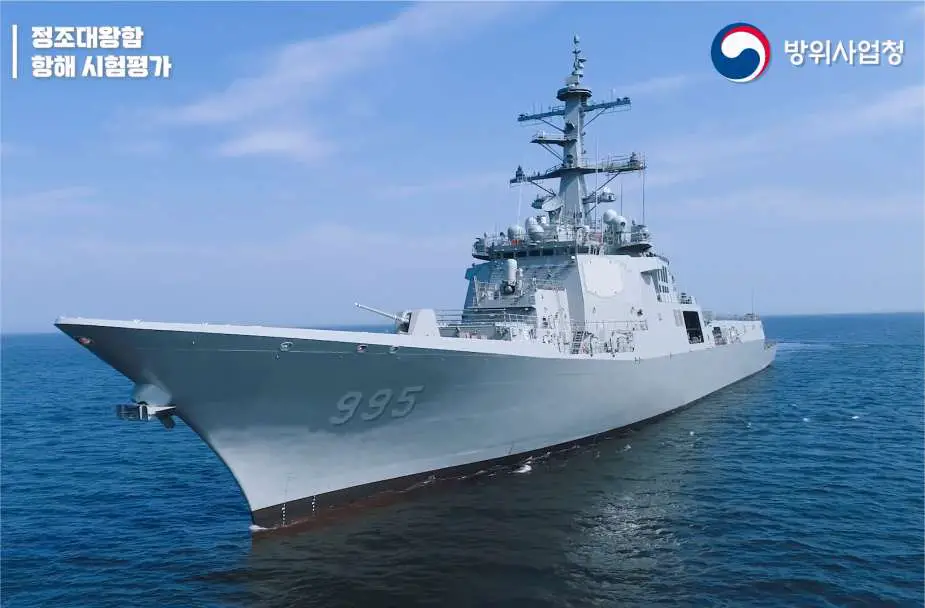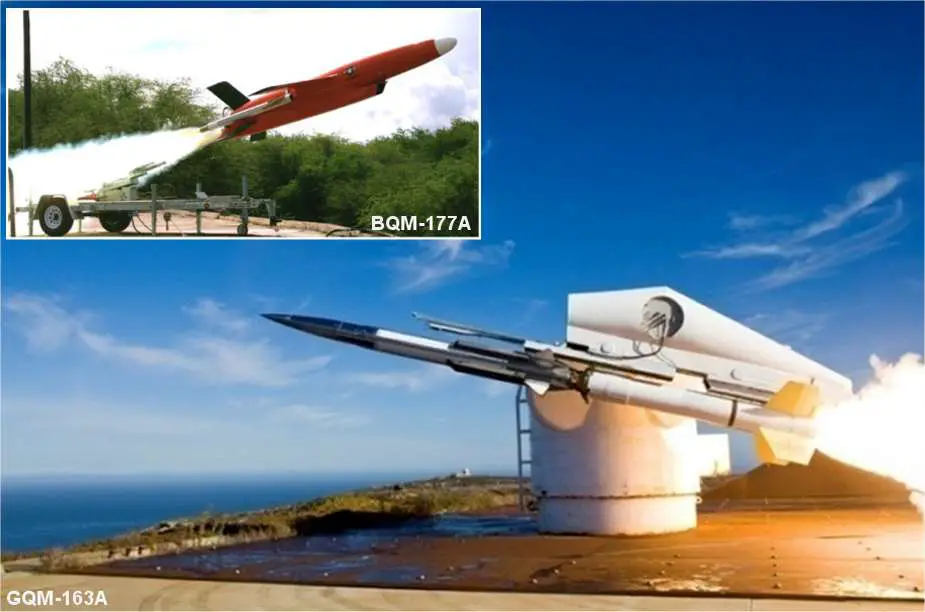On March 7, 2024, the US State Department announced the approval of a Foreign Military Sale to the Republic of Korea, valued at an estimated $170.6 million. The sale includes the provision of five BQM-177A and several GQM-163 Subsonic Sea-Skimming Aerial Targets (SSATs) intended for use with South Korea's KDX-III Batch-II Aegis-class destroyers.
Follow Navy Recognition on Google News at this link
 The Jeongjo the Great (DDG-995), launched on July 28, 2022, is the first KDX-III Batch-II Aegis-class destroyer of the South Korean Navy. (Picture source: DAPA)
The Jeongjo the Great (DDG-995), launched on July 28, 2022, is the first KDX-III Batch-II Aegis-class destroyer of the South Korean Navy. (Picture source: DAPA)
The equipment included in this FMS, particularly the aerial targets, is intended to support South Korea in the Combat System Ship Qualification Trials (CSSQT) for its KDX-III Batch-II Aegis-class destroyers. These trials are essential for confirming the operational efficiency and safety of the destroyers’ weapons launch and control systems. They also aim to validate the integrated operation of the hardware and assess the system's performance against established criteria. Furthermore, the supplied targets are designed to offer realistic training scenarios for the shipboard anti-air warfare teams.
The BQM-177A is designated as the US Navy's next-generation Sub-Sonic Aerial Target (SSAT), engineered to emulate high-subsonic, sea-skimming anti-ship cruise missile threats. This aerial target is designed to support a wide range of mission requirements through its ability to carry various internal and external payloads. These include scoring systems, Identification Friend-or-Foe (IFF), both passive and active RF augmentation, infrared (IR) augmentation such as fixed flares and plume pods, electronic countermeasures, and devices for dispensing chaff and flares.
The BQM-177A has a length of 5.18 meters, a wingspan of 2.13 meters, and a height of 1 m, with a dry weight of 281.23 kg. It is powered by a TR 60-5 turbojet engine, delivering a thrust of 453.59 kg. The maximum launch weight of the aerial target is 680.39 kg. It features a maximum internal payload capacity of 45.36 kg and a maximum wing-tip capacity of 38.56 kg per side. Operational capabilities allow for a maximum speed of 1.53 km/s (0.95 Mach) and an altitude of up to 12,192 m, with maneuverability ranging from -2G to +9G. The BQM-177A has a fuel capacity of 238.48 liters and a smoke oil capacity of 8.33 liters. Its command and control system can manage up to eight targets simultaneously. The system also includes features for IR and RF tow targets, captive wing pods for IR and RF, electronic countermeasures, and scoring capabilities.
On the other hand, the GQM-163A is a non-recoverable, supersonic aerial target capable of exceeding speeds of Mach 2, suitable for both sea-skimming and diving missions. The target measures 561.85 cm in length and 35.05 cm in diameter, with a weight range of 756.59 kg to 789.25 kg. Its operational capabilities include cruising at Mach 2.6 at an altitude of 15.24 meters for sea-skimming missions, with a terminal approach at 3.96 meters above sea level. For diving missions, it can cruise at Mach 3.8 at an altitude of 15,849.6 m, transitioning to a dive at speeds ranging from Mach 0.7 to Mach 3.0 down to 304.8 m. The target’s range extends to 83.34 km for sea-skimming missions and 220.39 km for diving missions.

The BQM-177A serves as a sub-sonic aerial target (SSAT), contrasting with the GQM-163A's role as a supersonic aerial target. (Picture source: NAVAIR and Kratos Defense)
The Sejong the Great-class destroyers are part of the Republic of Korea Navy's Korean Destroyer eXperimental (KDX) program. Named after the 15th-century Korean monarch Sejong the Great, these vessels are intended to update and enhance South Korea's naval capabilities, replacing the older Chungmugong Yi Sun-sin class destroyers. The program involves the construction of six ships, with each unit reported to cost $923 million.
As of now, four ships have been completed and deployed. Batch I ships includes the Sejong the Great (DDG-991), which was launched by Hyundai Heavy Industries on May 25, 2007, the Yulgok Yi I (DDG-992), launched on November 14, 2008, and the Seoae Ryu Seong-ryong (DDG-993), launched on March 24, 2011. The development of Batch II ships, exemplified by the launch of the Jeongjo the Great (DDG-995) on July 28, 2022, is expected to bring more electrical power (to accommodate more powerful radars and combat system), a higher level of automation to reduce the crew size, and the inclusion of the Aegis Baseline 9 and Aegis Ballistic Missile Defense System BMD 5.1 to shoot down ballistic missiles.
The primary mission of the Sejong the Great-class destroyers is to contribute to the Korea Air and Missile Defense (KAMD) system. They are equipped with the Aegis combat system Baseline 9.C2 'KII', allowing for integration with advanced missile defense technologies such as Raytheon's SM-6 and SM-3 missiles. This capability is intended to improve South Korea's defense against ballistic missile threats while enhancing its maritime surveillance and air defense capabilities.
Regarding technical specifications, the Sejong the Great-class has a standard displacement of 7,650 tons and a full load displacement of 10,600 tons. The ships from Batch 1 measure 166 meters in length, while Batch 2 ships are 170 meters long. Each ship has a beam of 21.4 meters and a draft of 6.25 meters. They are powered by four General Electric LM2500 COGAG engines, which enable them to achieve speeds above 30 knots. With a range of 5,500 nautical miles, these destroyers can remain at sea for up to 30 days and require a crew of 300 for their operations.
The detection and tracking capabilities of the Sejong the Great-class are enhanced by infrared detection and tracking equipment (IRST), electro-optical tracking systems (EOTS), and an integrated sonar system. These features aim to improve the ships' surveillance and anti-submarine warfare capacities, with an increased detection range facilitated by a larger hull-mounted sonar, the addition of a new variable depth sonar (VDS), and a multi-function towed array (MFTA).
The armament of the Sejong the Great-class includes a 5-inch (127 mm)/L62 caliber Mk 45 Mod 4 naval gun, 30 mm Goalkeeper CIWS, RAM Block 1 CIWS, and various missiles such as SSM-700K Haeseong anti-ship missiles, K-ASROC Red Shark anti-submarine rockets, and Hyunmoo III land-attack cruise missiles. They possess a Vertical Launching System with 128 cells for different types of missiles. The ships are also equipped to support aviation operations, with facilities for two Super Lynx or SH-60 Seahawk helicopters. Additionally, there are plans to expand their capabilities, including the deployment of a new Ship to Surface Ballistic Missile from the KVLS-II system, known as Hyunmoo-IV-2.



